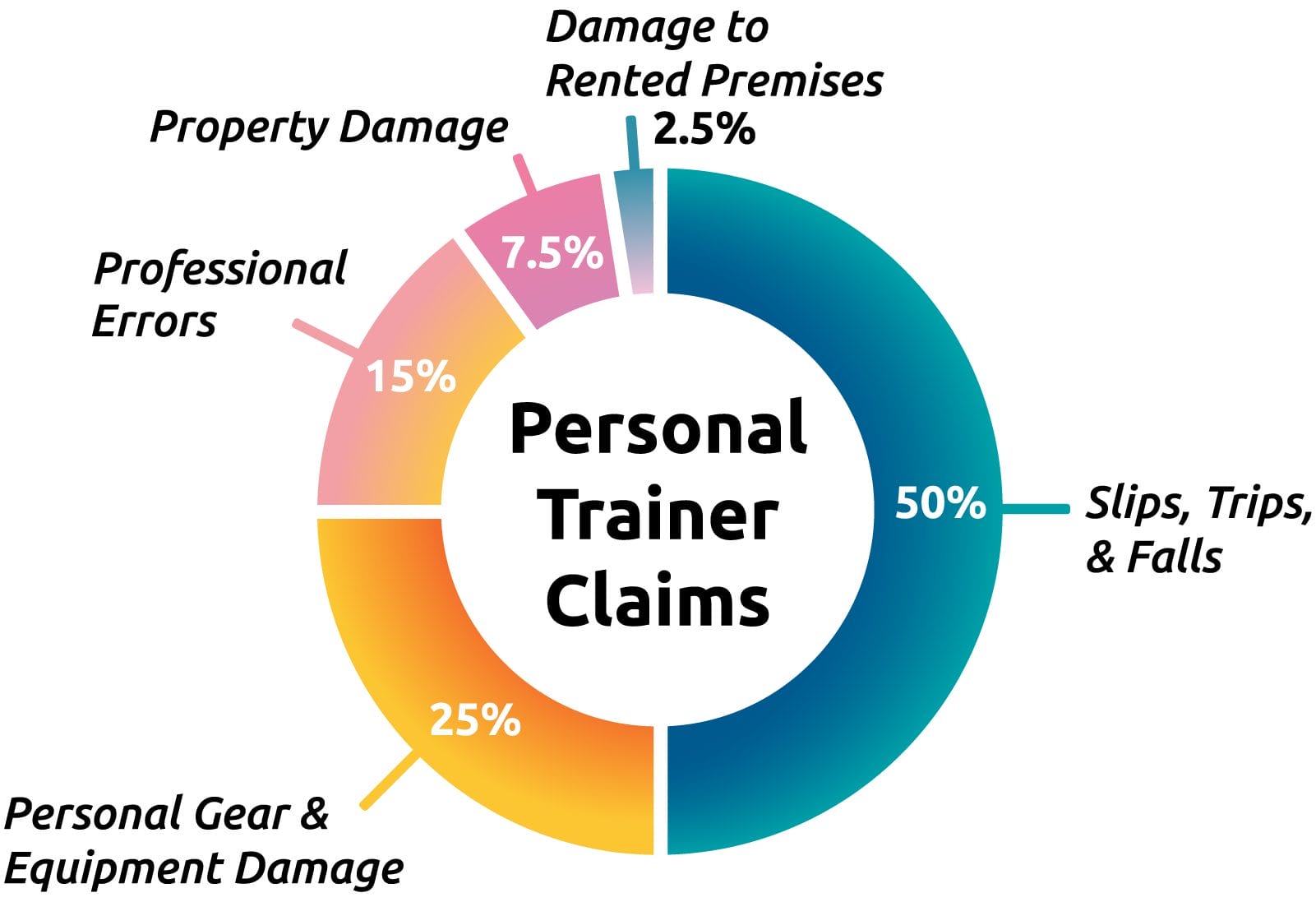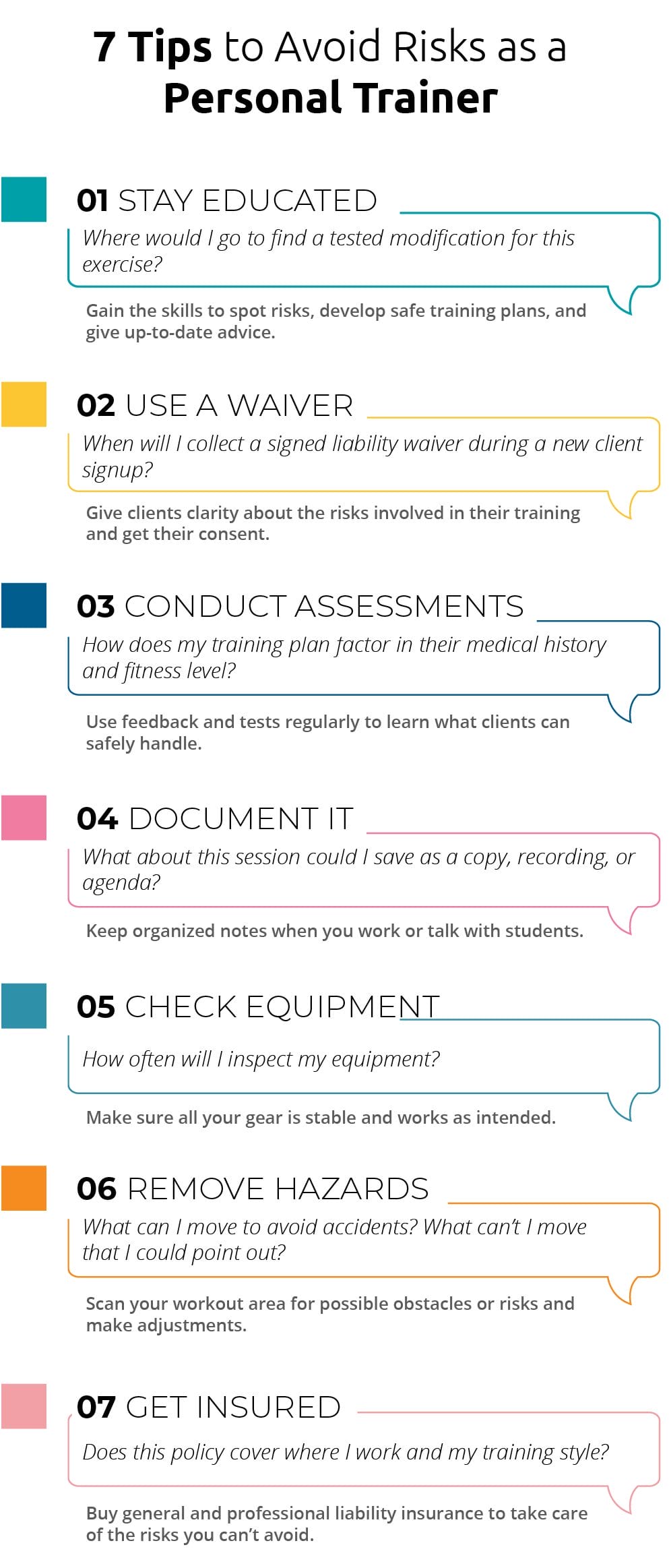- Last Updated
- Tricia Johnson
- June 19, 2024
It’s your nightmare scenario: you turn away from a training client for just a second—suddenly, weights crash to the ground, and you hear a gasp of pain.
Every day, over 10,000 exercise, sports, and recreation injuries result in emergency room trips nationwide. If your client decides to fault their trainer, paying for injuries, broken equipment, and more can fall on you.
At Insurance Canopy, we’ve seen our fair share of personal trainer lawsuits. Since 2020, our average payout for defending a personal trainer liability claim is $31,218, with some claims ranging into hundreds of thousands of dollars.
Without insurance, an accident that took a split second can hamstring your finances for years.
But that doesn’t have to be your story.
No one likes thinking about lawsuits, but getting prepared for the hurdles ahead can strengthen your business and give you the peace of mind to train fearlessly.
Read about the most common lawsuit causes, real claims cases personal trainers have faced, and ways to sidestep the risks of your job.
What Are the Main Causes of Personal Trainer Lawsuits?
We turned to our records to find the top reasons for personal trainer liability claims and the negligence lawsuits that can follow.
Here are the major personal trainer risks we discovered that could leave you on the hook financially:

*Percentages based on Insurance Canopy Personal Trainer claims submitted since 2020
Slips, Trips, and Falls
In a busy gym full of heavy, bulky, and complex equipment, injuries are tough to avoid.
On the insurance side, we see the most gym negligence cases involving client injuries. 50% of our claims involve physical injuries like students tripping in a cluttered studio, falling during an exercise, or accidentally harming others during a class.
Personal Gear & Equipment Damage
From streaming equipment for online classes to weights and training aids, it takes a lot of gear to get your clients to their goals. When that expense comes out of your own pocket, broken or missing items can be especially frustrating.
Lost, stolen, or damaged equipment factors into 25% of our personal trainer claims.
Professional Errors
Since your job revolves around the advice you give, your expertise can come under attack when something goes wrong.
15% of our claims fit the category of professional errors and omissions. These are scenarios in which clients blame you for not achieving the results they expect, giving advice that resulted in injury, or failing to check for pre-existing conditions.
Property Damage
Property damage accounts for 7.5% of our personal trainer claims. Common claims include harm to training rooms, like broken mirrors and dented floors, damage to clients’ property, and damage to gym machinery.
Trainers see plenty of property damage lawsuits since there’s usually a fitness center to negotiate with in addition to a client.
Damage to Rented Premises
Slightly different than typical property damage, insurance often classifies specific types of damage to spaces you rent separately.
Personal trainers frequently rent training rooms from gyms and health clubs, which opens them up to the risk of responsibility for major damages in the event of a fire in the building.
You might be asking, does that actually happen? It did to our clients. 2.5% of our personal trainer claims came from fire damage to rented premises.
Examples of Lawsuits Against Personal Trainers
You work hard to avoid accidents and injuries on the job, but lawsuits against personal trainers who are just as careful happen all the time. That’s why personal trainers need insurance against expensive claims.
We changed the names, but these personal trainer lawsuit scenarios come from real fitness pros like you with Insurance Canopy policies.
Julia: $3,000 Property Damage Claim
Julia teaches a beginner fitness class online. One of her videos shows students how to add resistance bands to their workout.
While they were following along with her video at the gym, someone’s band slipped off and shattered a glass door. This person claimed that Julia’s instructions were faulty, so we helped Julia pay $3,000 in property damage to the gym.
Mia: $43,175 Injury Claim
In the middle of Mia’s teaching, one of the students in her fitness class tripped over kettlebells left on the floor after the last exercise. The student was seriously hurt and needed surgery.
Mia was liable for $43,175 to pay the medical bills and the wages her student lost while they recovered at home. We helped her cover these costs.
Leon: $217,814 Injury Claim
Leon’s client was on the leg press machine during his training session at the gym. Leon stepped away for a few seconds to answer a call, and his client was injured.
The client sued Leon and the gym where he worked for negligence. We were able to help cover $217,814 in medical bills and legal fees for Leon and his employer.
How to Protect Yourself from Personal Trainer Liability Claims
Avoiding expensive personal trainer lawsuits is all about knowing your risks and thinking ahead. Proactively looking for hazards protects your business and builds your reputation as an instructor who cares about your students.
To enjoy safe sessions, check out our top tips to help personal trainers avoid risks.

1. Get Certified and Stay Current
Personal trainer certification programs can do more than help you land a job with a gym.
Accredited courses teach the safest and most accepted training methods while showing trainers how to check medical history, modify workouts, and other important steps to reduce risk.
Another benefit of certification is the push to keep your fitness methods up to date. Since renewal usually requires continuing education, a licensing program prompts you to keep up with the latest industry news, techniques, and risk management strategies.
2. Use a Personal Trainer Liability Waiver
Training asks your body to do something new. That means almost every gain in fitness comes with a little risk.
To protect your clients physically and yourself legally, it’s best to be open about the chance of injury. That’s where a liability waiver comes in.
A liability waiver is a legal document that tells clients about the health risks of their exercise program. Their signature means they agree to take on those risks, which may protect you from blame for accidents (in some situations). Smart times to use a waiver include:
- New client onboarding
- Introducing special equipment
- Online training sessions
- Group fitness classes
But a waiver can be about more than covering yourself. Frame it to clients as a chance for them to ask questions and adjust their program to fit them perfectly.
Our free, downloadable liability waiver template is an easy starting point for an open conversation about understanding their risks.
3. Assess Ability and Health
Building a strong foundation for future sessions is part of responsible training. Turns out, it’s healthy for your business, too.
Performing health and fitness tests before training—and making regular adjustments based on your client’s feedback and progress—helps you create effective workouts that minimize risk.
Screening tools like health questionnaires and movement assessments exist to spot health risks before they become a problem.
Failing to ask about pre-existing conditions is a common feature of personal trainer negligence lawsuits, but it’s one you can easily avoid.
4. Document Your Process
Strong notetaking not only helps you keep track of clients’ progress—it might save you from a big claim payout.
In gym negligence cases, records that show you checked all the boxes on your legal duties to your client are some of the best evidence you can offer.
Solid records on the following can help build your case:
- Agendas for meetings
- Health tests
- Medical clearance forms
- Signed waivers
- Class attendance lists
- Emails, phone calls, and texts
- Lesson plans
- Injury reports
For sessions, many personal trainers use the SOAP notes method to record subjective and objective observations, assessments, and plans for next steps.
Documentation is a win/win/win for a better view of your client, a boost in professional credibility, and a way to clear up confusion about your actions during a lawsuit.
5. Check Your Equipment
Adding fitness equipment to your training can increase clients’ gains—and risks.
Resistance training and weightlifting add user error and equipment failure to the usual risks of exercise, so it’s not surprising that they account for the most workout-related injuries.
A beefy 65.7% of gym injuries result from weights and weight machines alone.
To account for the factors you can control, test exercise gear often to make sure it still works.
Likewise, check that your clients understand safety features and correct form before giving them the go-ahead to use equipment.
6. Keep Training Areas Clear
- Is the ground even?
- Is equipment safely stowed away?
- Where will students put their coats and bags so that they’re out of the way?
7. Get General & Professional Liability Insurance
Personal trainers need insurance that protects them and their place of business from expensive claims. That means general liability insurance for slips, trips, falls, and dings and professional liability to cover your expert advice and services.
At Insurance Canopy, we know the unique risks you face in the fitness industry. Our Personal Trainer Insurance combines general liability and professional liability coverage to keep you protected from first meeting to final session.
We can cover online and in-person training at a variety of locations, property rented to you, and 100+ training styles.
Personal trainer lawsuits are a risk of the job. Now that you understand your biggest hazards, how to get coverage, and how to avoid common claims, you can stay sharp and create better, safer sessions for your clients.





